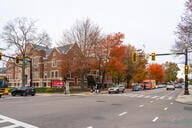You have /5 articles left.
Sign up for a free account or log in.
The National Science Foundation has completed the first phase of an experiment to tap outside expertise to design tools for a better understanding of the skills needed for jobs at the large federal agency, which employs 2,100 workers at its headquarters in Alexandria, Va.
The project, dubbed the Career Compass Challenge, aims to tap technology such as artificial intelligence to map the knowledge and skills its employees need and have earned. Its goal is to help employees plot a path for changing careers or moving up in their current job, and to assist them in continuously developing their skills.
The agency described its vision of this form of lifelong learning on a website about the experiment.
“Imagine a mechanism that rapidly enables an individual to match their skills and interests to current and future work opportunities, leveraging advanced technologies which incorporate learning and development needs (traditional, nontraditional and experiential) and that provides direct access to options for obtaining the relevant expertise to ready the individual for the chosen work,” it said.
A motivator for the NSF is its own struggle to have an adaptable and prepared work force.
“Federal employees no longer stay on a linear career path in the same field for most of their careers. Instead, many employees are branching out by making lateral moves into different fields,” the agency said.
The NSF said the HR challenges it faces are not unique.
“No industry will be immune to the way advances in technology change the nature of work. As a pressing example, we are facing critical gaps in matching people with data science and cybersecurity skills with the right mission needs,” it said. “NSF believes that, along with other agencies and organizations, the best way to maintain a work force ready to carry out its mission is to encourage a culture of continuous learning, and to empower each person to refresh and modernize their skills toward future work.”
A successful outcome for the project might be just to help to spur a national conversation about how to modernize the American work force through giving people more information about career trajectories, said Robyn Rees, budget lead and governance and strategy adviser for information technology at the agency.
“Might we stimulate the economy to respond to a need for the federal government?” she said. “The goal is to see what’s possible.”
Tool for the Federal Work Force
Even so, the experiment also is designed to create a specific, technology-powered application for defining job skills first at the NSF, then across the federal government. And the agency plans to share publicly what it learns and develops for possible use by the private sector.
Five Winner Papers
NSF selected five white papers to help guide the prototype tool's creation:
- "A GPS for Learning and Work," by Peter Smith, which envisions a case-based approach to recording and validating learning and linking it to college credentials and job requirements;
- "E-TAG: Employee Training and Growth Through Electronic Games," by April Edwards and Lynne Edwards, which describes an online gaming platform to evaluate workers' skills and give guidance on how to better apply and develop them;
- "My Career Compass," by C2 Technologies and George Mason University, which examines how to use emerging technologies to help workers select customized career-path options;
- "ACCESS: An Integrated Service Platform for Preparing Future Workforce," by Zhe Sage Chen, which describes a personalized, technology-driven career compass that provides data-driven job market recommendations and continuous learning strategies; and
- "The Career CHARTING App," by Beverly P. Woolf and Andrew S. Lan, which envisions an application to analyze a worker’s skills, propose future careers, suggest growth paths and provide training options.
Rees said the NSF broke the work into two parts. First came a call for big idea concept papers from higher education, industry and beyond. The next phase, which it begins on April 15, is a competition for proposals to build a prototype. Authors of the winning concept papers each get a $5,000 prize from the NSF, while the prototype design comes with a $75,000 prize.
On Friday the agency released the five papers it selected from among roughly 60 submissions. Most of the authors work in higher education. And their papers generally envision a role for colleges in helping employees at NSF and other federal agencies develop their skills.
One of the winning papers was written by Peter Smith, endowed chair and professor of innovative practices in higher education at the University of Maryland University College. Smith’s paper describes a “GPS for learning and work,” which would use a case-based approach to validate and record learning by NSF employees, and link that knowledge and skill with college credentials and job requirements.
The GPS system would assess and map common skills needed for the hierarchical levels of federal jobs across agencies -- say a GS-7 -- as well as what an employee at that level knows and can do in a particular agency and role. Smith said the GPS also would determine what those skills should be worth academically, through college credits and credentials.
As a hypothetical, Smith said perhaps a GS-7 at the Environmental Protection Agency would have enough competencies to have earned half of a master’s degree.
Algorithms, AI and other emerging technologies make this form of prior learning assessment possible, said Smith, an author and former U.S. congressman who has held an unusually wide variety of jobs in higher education, including as the founding president of a community college and a regional public university, as well as a stint at Kaplan Higher Education.
“It comes down to the mapping,” he said. “That’s something we couldn’t do 20 years ago.”
Rees agreed that technology opens doors for the NSF in its “talent review process.” She said the challenge project seeks to crowdsource ideas for using AI and other tools to devise quicker and more intuitive ways to work with data about jobs.
“We want people to join the conversation,” said Rees.
The NSF’s stature and reputation for rigor could boost broader efforts to develop and use more granular skills data, Smith said. And it would be a big deal if the NSF succeeds in creating a careers app for the huge federal work force.
He described the experiment by the highly respected government agency as a “real potential lever.”
The NSF also wants its project to help prod broad change in work-force development.
“We want to spark the thinking of the best and brightest to co-create a solution that can enable individual skill matching and tailored training for the work force for the 21st century,” the agency said.




